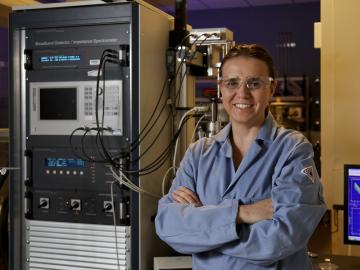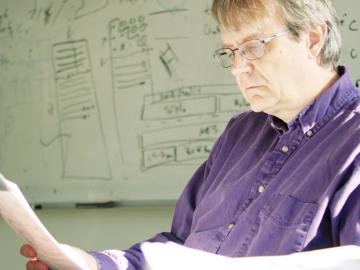
Filter News
Area of Research
- (-) Energy Science (126)
- (-) Materials (108)
- (-) Supercomputing (68)
- Advanced Manufacturing (6)
- Biology and Environment (69)
- Biology and Soft Matter (1)
- Building Technologies (2)
- Computational Engineering (1)
- Computer Science (3)
- Electricity and Smart Grid (3)
- Energy Frontier Research Centers (1)
- Energy Sciences (1)
- Functional Materials for Energy (1)
- Fusion and Fission (14)
- Fusion Energy (8)
- Isotopes (25)
- Materials for Computing (16)
- Mathematics (1)
- National Security (13)
- Neutron Science (23)
- Nuclear Science and Technology (19)
- Nuclear Systems Modeling, Simulation and Validation (1)
- Quantum information Science (3)
- Sensors and Controls (1)
News Topics
- (-) Advanced Reactors (10)
- (-) Frontier (32)
- (-) Grid (42)
- (-) Isotopes (14)
- (-) Nanotechnology (43)
- (-) Physics (34)
- (-) Polymers (22)
- 3-D Printing/Advanced Manufacturing (91)
- Artificial Intelligence (43)
- Big Data (27)
- Bioenergy (33)
- Biology (20)
- Biomedical (25)
- Biotechnology (6)
- Buildings (39)
- Chemical Sciences (33)
- Clean Water (10)
- Composites (19)
- Computer Science (110)
- Coronavirus (26)
- Critical Materials (21)
- Cybersecurity (14)
- Energy Storage (86)
- Environment (79)
- Exascale Computing (27)
- Fossil Energy (2)
- Fusion (8)
- High-Performance Computing (46)
- Hydropower (3)
- Irradiation (1)
- ITER (1)
- Machine Learning (20)
- Materials (99)
- Materials Science (95)
- Mathematics (4)
- Mercury (3)
- Microelectronics (1)
- Microscopy (31)
- Molten Salt (3)
- National Security (11)
- Neutron Science (49)
- Nuclear Energy (26)
- Partnerships (16)
- Quantum Computing (21)
- Quantum Science (34)
- Security (11)
- Simulation (18)
- Software (1)
- Space Exploration (8)
- Statistics (1)
- Summit (44)
- Transportation (74)
Media Contacts

A team of researchers at Oak Ridge National Laboratory have demonstrated that designed synthetic polymers can serve as a high-performance binding material for next-generation lithium-ion batteries.

Scientists have discovered a way to alter heat transport in thermoelectric materials, a finding that may ultimately improve energy efficiency as the materials

OAK RIDGE, Tenn., May 7, 2019—The U.S. Department of Energy today announced a contract with Cray Inc. to build the Frontier supercomputer at Oak Ridge National Laboratory, which is anticipated to debut in 2021 as the world’s most powerful computer with a performance of greater than 1.5 exaflops.

In a step toward advancing small modular nuclear reactor designs, scientists at Oak Ridge National Laboratory have run reactor simulations on ORNL supercomputer Summit with greater-than-expected computational efficiency.

Scientists at Oak Ridge National Laboratory have developed a low-cost, printed, flexible sensor that can wrap around power cables to precisely monitor electrical loads from household appliances to support grid operations.

OAK RIDGE, Tenn., March 11, 2019—An international collaboration including scientists at the Department of Energy’s Oak Ridge National Laboratory solved a 50-year-old puzzle that explains why beta decays of atomic nuclei

Vera Bocharova at the Department of Energy’s Oak Ridge National Laboratory investigates the structure and dynamics of soft materials.

More than 1800 years ago, Chinese astronomers puzzled over the sudden appearance of a bright “guest star” in the sky, unaware that they were witnessing the cosmic forge of a supernova, an event repeated countless times scattered across the universe.
OAK RIDGE, Tenn., Feb. 12, 2019—A team of researchers from the Department of Energy’s Oak Ridge and Los Alamos National Laboratories has partnered with EPB, a Chattanooga utility and telecommunications company, to demonstrate the effectiveness of metro-scale quantum key distribution (QKD).

OAK RIDGE, Tenn., Feb. 8, 2019—The Department of Energy’s Oak Ridge National Laboratory has named Sean Hearne director of the Center for Nanophase Materials Sciences. The center is a DOE Office of Science User Facility that brings world-leading resources and capabilities to the nanoscience resear...


